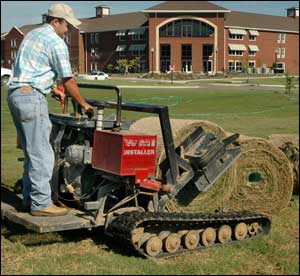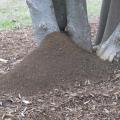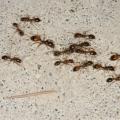Fire Ant Control In Commercial Sod and Nursery Stock
Although fire ants infest most of the southeastern United States (See Imported Fire Ant Quarantine Map), there are many states, or parts of states, where they do not yet occur. Fire ants could easily be transported to these areas by movement of infested soil. Such accidental transport could occur through movement of sod or nursery stock containing established colonies of fire ants or individual newly mated queens.
The United States Department of Agriculture maintains a quarantine against unregulated transport of soil or soil-containing items, including sod and nursery stock, from fire ant infested areas to uninfested areas. Sod and nursery stock shipped out of the quarantined area must have an appropriate inspection certificate and be treated according to USDA guidelines. Nurserymen and sod producers who plan to ship products outside the fire ant quarantine area need to be aware of the requirements that must be met and make arrangements for appropriate treatments and inspections well before the anticipated shipment date. Contact the Mississippi Department of Agriculture for specific details. See USDA APHIS Publication 81-25-001, Imported Fire Ant Quarantine Treatments for Nursery Stock, Grass Sod, and Related Materials for specific products and treatment protocols required for treating sod and nursery stock that will be shipped to areas outside the imported fire ant quarantine zone.
- Fire Ant Biology
- Mississippi Department of Agriculture, Bureau of Plant Industry, Plant Pest Control Programs, Imported Fire Ants
- Imported Fire Ant Quarantine Treatments for Nursery Stock, Grass Sod, and Related Materials
Contact information for Dr. Blake Layton.
Publications
News
Sunshine and long days make summertime in the South desirable for people, but those same conditions are exactly what allows the dreaded, imported fire ants to thrive.
Almost any sunny, grassy area left unattended will soon be home to fire ants. Fire ants were accidentally imported from South America to Mobile in the 1930s and have since spread throughout the Southeast.
Everyone loves a good myth buster, and we have a very timely one for you! Fire ant beds in your yard can be such a headache to deal with. Many people have used home remedies to control ants. But are those quick fixes really getting rid of the ants in your yard? Let’s take a look at some commonly used home remedies and whether or not they work!
Do you have fire ants in your vegetable garden? Me too. Good news for all of us! There are some fire ant baits that are safe to use around food plants.




